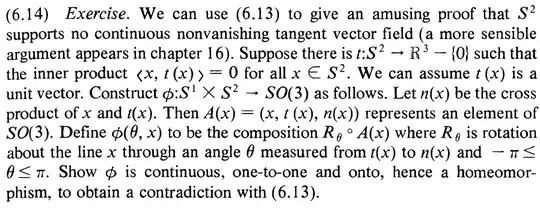This is the exercise (6.14) of Greenberg-Harper Algebraic Topology book.
I already showed continuity but I have problems for shows injectivity and surjectivity. For injectivity, if I assume $R_\theta \circ A(x)=R_{\theta^{\prime}} \circ A(x^\prime)$ (with $-\pi\leq \theta <\pi$) then $R_\theta \cdot A(x)=R_{\theta^{\prime}} \cdot A(x^\prime)$ (as matrix). But I dont Know how to conclude that $\theta=\theta^{\prime}$ and $x=x^\prime$.
Other form to show its, is defining the inverse of map. I think to define $\psi: SO(3)\to S^{1}\times S^{2}$ by $T \mapsto (T\cdot (A(T(e_1))^{-1}, T(e_1))$ (Here $T(e_1)$ denotes first column of $T$) and see if $T\cdot (A(T(e_1))^{-1}$ is the form $$T\cdot (A(T(e_1))^{-1}=\begin{bmatrix} 1 & 0 & 0 \\ 0 & \cos \theta &-\sin \theta\\ 0& \sin \theta &\cos \theta \end{bmatrix}$$ with finality to identify $T\cdot (A(T(e_1))^{-1}$ with an angle. But, I dont know if a matrix of $T\cdot (A(T(e_1))^{-1}$ has this form. I tried to prove its. Is easy see that $A((T(e_1))^{-1} \cdot T$ has a form described above. But what I want is that $T\cdot (A(T(e_1))^{-1}$ but to have the form described above.
I also tried to do the same by taking $T(e_1)$ as the first row instead of the first column but still can't see that it has the required form.
